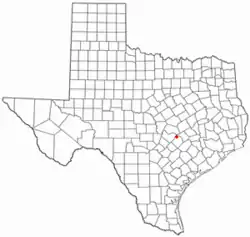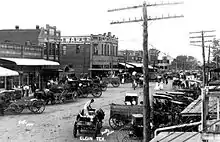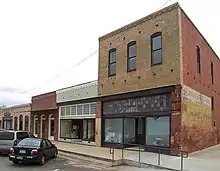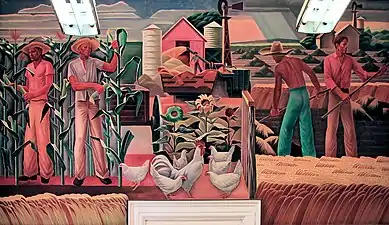Elgin, Texas | |
|---|---|
.jpg.webp) Elgin City Hall is located in the historic Dr. I. B. Nofsinger House | |
| Nicknames: Brick Capital of the Southwest; Sausage Capital of Texas | |
| Motto: "Perfectly Situated" | |
 Location of Elgin, Texas | |
 | |
| Coordinates: 30°20′55″N 97°22′21″W / 30.34861°N 97.37250°W | |
| Country | United States |
| State | |
| Counties | Bastrop, Travis |
| Government | |
| • Type | Home Rule, Council-Manager form |
| • Mayor-at-Large | Theresa McShan |
| • City Council | City Council |
| Area | |
| • Total | 6.62 sq mi (17.15 km2) |
| • Land | 6.62 sq mi (17.15 km2) |
| • Water | 0.00 sq mi (0.00 km2) |
| Elevation | 581 ft (177 m) |
| Population (2020) | |
| • Total | 9,784 |
| • Density | 1,557.77/sq mi (601.49/km2) |
| Time zone | UTC-6 (Central (CST)) |
| • Summer (DST) | UTC-5 (CDT) |
| ZIP code | 78621 |
| Area code | 512 & 737 |
| FIPS code | 48-23044[3] |
| GNIS feature ID | 1373617[4] |
| Website | elgintx |
Elgin (/ˈɛlɡɪn/ EL-ghin) is a city in Bastrop County in the U.S. state of Texas. The population was 9,784 at the 2020 census.[5] Elgin is also known as the Sausage Capital of Texas[6] and the Brick Capital of the Southwest,[7] due to the presence of three operating brickyards in the mid-20th century (two of which are still open).
History

In 1871, the Houston and Texas Central Railroad (succeeded by the Southern Pacific Transportation Company) built through the area and established a flag stop called Glasscock named for George W. Glasscock, a local resident and Republic of Texas soldier who lived in the area in the 1830s. Glasscock was renamed on August 18, 1872, for Robert Morris Elgin, the railroad's land commissioner, following the practice of naming new railroad towns after officers of the company.[7] Elgin was established. The original plat placed the train depot in the center of a one-square-mile area.
The original plan for the Houston and Texas Central Railroad was to have run from McDade, 10 miles (16 km) east of Elgin, southwest to the Colorado River at a point somewhere between Bastrop and Webberville, then to Austin following the river. These plans, however, were thwarted due to a major flood of the Colorado River in 1869, hence the rerouting of the railroad through what is now Elgin.
Elgin was incorporated, received a post office in 1873, and a Baptist Sunday school began meeting in a private home. Much of the town's early population was drawn from nearby Perryville, which the railroad had bypassed. Perryville, or Hogeye as it was nicknamed, was located 2.5 miles (4.0 km) to the south. The town was known by three different names: the name Young's Settlement was chosen, probably in honor of the Michael Young family; Perryville, possibly for Perry Young, who was Michael Young's son; and Hogeye.[8] The post office was officially named Young's Settlement, and the churches and Masonic Lodge carried the name Perryville. The name Hogeye was given to the stage stop at the Litton home where dances were held and, according to legend, the fiddler knew only one tune: "Hogeye", which he played over and over as the crowd danced on the puncheon floor.
In 1879, Elgin was described as a "thriving depot town" of 400. It had a newspaper, a gin, and a gristmill. Three years later Methodists erected the first church building in town. In 1884, Elgin had five general stores, two druggists, three cotton gins, and a saloon; that year, Thomas O'Conner started a brick-making enterprise that eventually led Elgin to adopt the epithet "Brick Capital of the Southwest." In 1885, a group of citizens met in Elgin to organize a new north-south railroad which would run from Taylor, the rail head for the Missouri, Kansas and Texas ("Katy") Railroad 16 miles (26 km) to the north, through Elgin to Bastrop, the county seat, 16 miles (26 km) to the south. The Taylor, Elgin, and Bastrop Railroad was formed in 1886 and began building the line. That same year, the "Katy" acquired the line and continued the construction on to Houston. Thus, Elgin became the beneficiary of two major rail lines with eight passenger trains daily, adding to Elgin's business as a shipping point for cotton, wool, and livestock. By 1890, Elgin had a population of 1,100 and supported two hotels, a broom factory, two doctors, a dentist, and the Elgin Courier newspaper. The following year oil was discovered 5 miles (8 km) southeast of town, but the strike was not large. Coal proved better for the economy, when the large coal belt nearby was mined in the early 20th century, bringing Latin-Americans and African-Americans to the area, as both free and slave labor.
The year 1900 resulted in a bumper crop of cotton and Elgin prospered. Elgin grew slowly but steadily through the 20th century, from 1,258 in 1904 to 4,846 in 1990. The city incorporated in 1901, electing Charles Gillespie, building contractor, as mayor, as well as J.D. Hemphill as marshal, W.E. McCullough, J. Wed Davis, Ed Lawhon, Max Hirach, and F.S. Wade as aldermen. Local law enforcement was established to enforce newly established civil and criminal codes. By 1910, Elgin was enjoying a period of great prosperity as families from out on the prairie and surrounding communities moved to town and built nice homes.
By 1940, Elgin was also the site of two big brick and tile plants. Elgin enterprise was stimulated during World War II by the proximity of the army training facility Camp Swift. A third brick company was established in the town in the mid-1950s, lured by the high-quality clay deposits in the area. In addition to the brick plants, a local sausage factory processed thousands of pounds of beef and pork a week; Elgin Hot Sausage continued to enjoy a widespread reputation, and Elgin rapidly became the most important agricultural center in Bastrop County. Five cotton gins and a cotton oil mill were in operation at the same time. Other industries included feed and grain processing and hydraulic press manufacturing.
By the 1980s, proximity to Austin had begun to attract commuters to Elgin. In the mid-1980s, the Elgin Courier was still being published, the sausage had achieved wider fame, and two brick and tile plants were still in operation. Elgin was also the site of a furniture plant and a leather works.
The eastern side of town was heavily damaged by a high-end EF2 tornado on March 21, 2022.[9]
Downtown

The Elgin Commercial Historic District includes 14 city blocks of commercial and industrial buildings. Most of these buildings are constructed of locally produced brick and were erected from 1872 to 1947. The Elgin Commercial Historic District was added to the National Register of Historic Places in 1996. Within the 14-block district, 67 buildings are considered contributing structures. A contributing structure is one which has maintained its architectural integrity. Southside includes Central Avenue and Avenue C in the downtown district. Five buildings are under restoration in the Southside area. During the past 14 years, private property owners, business owners, and the public sector have invested about $9 million in the downtown area. A majority of the buildings on Main Street, from Depot Street to First Street, have been restored or renovated, and many are currently under renovation. Local developer Allan Tolbert III has renovated a total of 7 historic buildings. Including the original Southside (Sausage) located on Central Ave. Market building on The Elgin Main Street Program provides a variety of incentives to building owners such as a discounted paint program, free dumpsters, and free advice on architectural design and restoration.
Elgin became a Texas Main Street city in 1990, and in 1999, 2000, and 2001 was selected as a National Main Street Community. Main Street is a national approach to saving our heritage by preserving historic downtown areas. Each year, three cities are selected by the Texas Historical Commission and Anice Read Main Street Center to become Main Street Cities. Communities make a commitment to hire a staff person, provide office space, supplies, and a small budget. The primary commitment is to preserving and revitalizing the historic commercial business district. Volunteerism is a key part of the success of any Main Street program.
Geography
Elgin is located 25 miles (40 km) east of downtown Austin and 18 miles (29 km) north of Bastrop,[10] at the intersection of U.S. Highway 290 and State Highway 95.[7] Most of the city lies in Bastrop County, with a portion extending westward into Travis and Williamson Counties. Most of north Elgin is built on blackland prairie soil.
Climate
The climate in this area is characterized by hot, humid summers and generally mild to cool winters. According to the Köppen Climate Classification system, Elgin has a humid subtropical climate, Cfa on climate maps.[11]
| Climate data for Elgin, Texas (1 mile north) (1991–2020 normals, extremes 1963–2020) | |||||||||||||
|---|---|---|---|---|---|---|---|---|---|---|---|---|---|
| Month | Jan | Feb | Mar | Apr | May | Jun | Jul | Aug | Sep | Oct | Nov | Dec | Year |
| Record high °F (°C) | 89 (32) |
98 (37) |
96 (36) |
100 (38) |
100 (38) |
107 (42) |
107 (42) |
108 (42) |
110 (43) |
97 (36) |
91 (33) |
86 (30) |
110 (43) |
| Mean daily maximum °F (°C) | 60.8 (16.0) |
64.3 (17.9) |
71.3 (21.8) |
78.5 (25.8) |
85.2 (29.6) |
91.8 (33.2) |
95.0 (35.0) |
96.2 (35.7) |
90.0 (32.2) |
81.3 (27.4) |
70.1 (21.2) |
62.2 (16.8) |
78.9 (26.1) |
| Daily mean °F (°C) | 50.0 (10.0) |
53.5 (11.9) |
60.3 (15.7) |
67.6 (19.8) |
75.0 (23.9) |
81.5 (27.5) |
84.1 (28.9) |
84.6 (29.2) |
78.9 (26.1) |
69.9 (21.1) |
59.4 (15.2) |
51.7 (10.9) |
68.0 (20.0) |
| Mean daily minimum °F (°C) | 39.2 (4.0) |
42.7 (5.9) |
49.4 (9.7) |
56.7 (13.7) |
64.8 (18.2) |
71.2 (21.8) |
73.3 (22.9) |
73.0 (22.8) |
67.9 (19.9) |
58.4 (14.7) |
48.7 (9.3) |
41.1 (5.1) |
57.2 (14.0) |
| Record low °F (°C) | 7 (−14) |
10 (−12) |
17 (−8) |
33 (1) |
42 (6) |
54 (12) |
62 (17) |
59 (15) |
44 (7) |
29 (−2) |
21 (−6) |
0 (−18) |
0 (−18) |
| Average precipitation inches (mm) | 2.96 (75) |
2.06 (52) |
3.15 (80) |
2.73 (69) |
4.86 (123) |
2.98 (76) |
1.97 (50) |
2.32 (59) |
2.97 (75) |
4.02 (102) |
3.07 (78) |
3.00 (76) |
36.09 (917) |
| Average snowfall inches (cm) | 0.0 (0.0) |
0.0 (0.0) |
0.0 (0.0) |
0.0 (0.0) |
0.0 (0.0) |
0.0 (0.0) |
0.0 (0.0) |
0.0 (0.0) |
0.0 (0.0) |
0.0 (0.0) |
0.0 (0.0) |
0.0 (0.0) |
0.0 (0.0) |
| Average precipitation days (≥ 0.01 in) | 5.7 | 5.8 | 6.8 | 5.2 | 6.0 | 5.9 | 4.4 | 3.8 | 5.5 | 5.8 | 4.8 | 5.7 | 65.4 |
| Average snowy days (≥ 0.1 in) | 0.1 | 0.0 | 0.0 | 0.0 | 0.0 | 0.0 | 0.0 | 0.0 | 0.0 | 0.0 | 0.0 | 0.0 | 0.0 |
| Source: NOAA[12][13] | |||||||||||||
Education
Elgin is served by the Elgin Independent School District, which covers more than 168 square miles (440 km2) in portions of Bastrop, Lee, Williamson, and Travis Counties, and provides educational facilities and resources to meet the needs of more than 4,000 students as of 2010.[14]
The Texas Legislature designated Travis and Bastrop counties as being in the boundary of Austin Community College's district.[15] ACC opened its ACC Elgin branch in the city in 2013.[16]
Demographics
| Census | Pop. | Note | %± |
|---|---|---|---|
| 1910 | 1,707 | — | |
| 1920 | 1,630 | −4.5% | |
| 1930 | 1,823 | 11.8% | |
| 1940 | 2,008 | 10.1% | |
| 1950 | 3,168 | 57.8% | |
| 1960 | 3,511 | 10.8% | |
| 1970 | 3,832 | 9.1% | |
| 1980 | 4,535 | 18.3% | |
| 1990 | 4,846 | 6.9% | |
| 2000 | 5,700 | 17.6% | |
| 2010 | 8,135 | 42.7% | |
| 2020 | 9,784 | 20.3% | |
| U.S. Decennial Census[17] | |||
| Race | Number | Percentage |
|---|---|---|
| White (NH) | 3,101 | 31.69% |
| Black or African American (NH) | 1,538 | 15.72% |
| Native American or Alaska Native (NH) | 11 | 0.11% |
| Asian (NH) | 47 | 0.48% |
| Some Other Race (NH) | 34 | 0.35% |
| Mixed/Multi-Racial (NH) | 302 | 3.09% |
| Hispanic or Latino | 4,751 | 48.56% |
| Total | 9,784 |
As of the 2020 United States census, there were 9,784 people, 3,033 households, and 2,158 families residing in the city.
As of the census of 2010,[21] there were 8,135 people. The population density was 1,402.6 inhabitants per square mile (541.5/km2). There were 2,948 housing units at an average density of 508.3 per square mile (196.3/km2). The racial makeup of the city was 57.14% White, 17.30% African American, 1.00% Native American, 0.49% Asian, 0.20% Pacific Islander, 20.12% from other races, and 3.75% from two or more races. Hispanic or Latino of any race were 45.67% of the population.
As of the census of 2000, there were 1,869 households, out of which 36.2% had children under the age of 18 living with them, 51.8% were married couples living together, 14.6% had a female householder with no husband present, and 27.8% were non-families. 22.3% of all households were made up of individuals, and 11.6% had someone living alone who was 65 years of age or older. The average household size was 2.98 and the average family size was 3.50.
In the city, the population was spread out, with 29.8% under the age of 18, 10.6% from 18 to 24, 28.4% from 25 to 44, 17.6% from 45 to 64, and 13.6% who were 65 years of age or older. The median age was 32 years. For every 100 females, there were 97.9 males. For every 100 females age 18 and over, there were 93.8 males.
The median income for a household in the city was $38,750, and the median income for a family was $48,125. Males had a median income of $31,368 versus $21,095 for females. The per capita income for the city was $16,698. About 10.4% of families and 16.1% of the population were below the poverty line, including 21.2% of those under age 18 and 21.7% of those age 65 or over.
Government and infrastructure


The U.S. Postal Service operates the Elgin Post Office. The post office has "Texas Farm," a mural by Julius Woeltz located above the door to the office of the postmaster. Created as part of the 1930s Federal Arts Project, it depicts men harvesting vegetables and picking corn.[22]
In 2022, city voters approved the decriminalization of possession of misdemeanor amounts of marijuana.[23]
Economy
The Chamber of Commerce is located in the original 1872 Houston and Texas Central Railroad building.
Sports
Ray Culp, a two-time Major League Baseball All-Star pitcher, was born in Elgin.
Elgin is host to three different sports for the youth of the community and surrounding area. Pop Warner football and cheer-leading squads, Elgin Youth Football, and Elgin Youth Soccer Association are available.
Little League World Series 2006
The Elgin Major Girls softball team came from behind in the consolation match-up with the team from Tennessee to win third place in the 2006 Softball World Series in Portland, Oregon. Tennessee defeated Elgin 5–4 in seven innings.[24]
Little League World Series 2007
Elgin Little League's Major Girls' softball All-Stars defended their Southwest Region Championship and earned a second straight trip to the World Series in 2007. The championship game slipped from the Elgin Major girls' hands in a very close game against the undefeated Mattawan Little League team from Michigan, losing 2–0. Elgin took home the second place title for the 2007 Little League World Series as the Southwest Region champion. Elgin advanced to the finals with a 5–0 record.
Notable people
- Ray Culp, Major League Baseball All-Star pitcher
- Jake Helgren, Film director, producer and screenwriter
- Chester Snowden, Artist and illustrator
- Otho Davis, Football trainer
Filmed in Elgin
Several notable films have used Elgin as a location:[25] They include:
- 1974 The Texas Chain Saw Massacre
- 1975 The Great Waldo Pepper
- 1982 The Best Little Whorehouse in Texas
- 1993 What's Eating Gilbert Grape
- 1993 A Perfect World
- 1995 The Big Green
- 1996 Michael
- 1999 Varsity Blues
- 2002 25th Hour
- 2002 The New Guy
- 2003 The Alamo
- 2006 A Scanner Darkly
- 2014 Transformers: Age of Extinction
- 2015 My All American
- 2018 Fear the Walking Dead
- 2019 Mercy Black
References
- ↑ "City Council". The City of Elgin. Retrieved December 19, 2016.
- ↑ "2019 U.S. Gazetteer Files". United States Census Bureau. Retrieved August 7, 2020.
- ↑ "U.S. Census website". United States Census Bureau. Retrieved January 31, 2008.
- ↑ "US Board on Geographic Names". United States Geological Survey. October 25, 2007. Retrieved January 31, 2008.
- ↑ "Geographic Identifiers: 2010 Demographic Profile Data (G001): Elgin city, Texas". U.S. Census Bureau, American Factfinder. Archived from the original on February 12, 2020. Retrieved April 9, 2014.
- ↑ House Resolution 705, 74th regular session of the Texas Legislature.
- 1 2 3 Paula Mitchell Marks. Texas State Historical Association (ed.). "ELGIN, TEXAS". The Handbook of Texas Online. Archived from the original on December 8, 2010. Retrieved April 13, 2010.
- ↑ Handbook of Texas Online entry on Perryville. Retrieved 2008-11-13.
- ↑ Texas Event Report: EF0 Tornado (Report). National Centers for Environmental Information. National Weather Service in Austin, Texas. 2022. Retrieved December 3, 2022.Texas Event Report: EF2 Tornado (Report). National Centers for Environmental Information. National Weather Service in Austin, Texas. 2022. Retrieved December 3, 2022.
- ↑ Google Maps
- ↑ Climate Summary for Elgin, Texas
- ↑ "NOWData - NOAA Online Weather Data". National Oceanic and Atmospheric Administration. Retrieved November 5, 2023.
- ↑ "Summary of Monthly Normals 1991-2020". National Oceanic and Atmospheric Administration. Retrieved November 5, 2023.
- ↑ City of Elgin-Education. Archived 2008-10-20 at the Wayback Machine Retrieved on 2008-11-12.
- ↑ Texas Education Code Sec. 130.166. AUSTIN COMMUNITY COLLEGE DISTRICT SERVICE AREA.
- ↑ "ACC opens its ninth campus in Elgin | kvue.com Austin". Archived from the original on February 3, 2014. Retrieved February 2, 2014.
- ↑ "Census of Population and Housing". Census.gov. Retrieved June 4, 2015.
- ↑ "Explore Census Data". data.census.gov. Retrieved May 24, 2022.
- ↑ https://www.census.gov
- ↑ "About the Hispanic Population and its Origin". www.census.gov. Retrieved May 18, 2022.
- ↑ 2010 Census Interactive Population Search
- ↑ Smith, Mark L. (January 17, 2017). "Post office mural rooted in Elgin, art history". Elgin Courier. Archived from the original on April 22, 2017. Retrieved January 22, 2017.
- ↑ "San Marcos, Elgin voters approve ballot measures to decriminalize marijuana within city limits". kvue.com. November 9, 2022. Retrieved November 10, 2022.
- ↑ Elgin Courier Retrieved on 2008-11-12.
- ↑ "Movies in Elgin". Archived from the original on April 11, 2009. Retrieved March 19, 2009.

